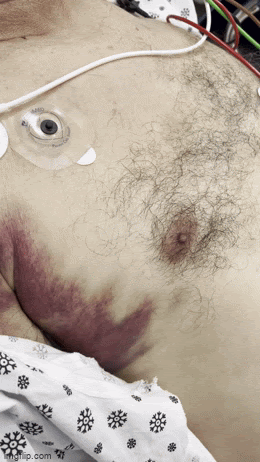
- An uncommon injury caused by three or more rib fractures in two places
- Injury resulting from blunt trauma such as a motor vehicle accident (75%), falls (15%) or direct percussion to the chest
- Causes decrease intrathoracic pressure, ineffective ventilation, and pulmonary contusion
- Pulmonary contusion is causes by small laceration of the alveoli leading to blood leak, shunt and atelectasis
- Often associated with other injuries including hemo/pneumothorax, head injury and major vascular injury
- Mortality rates from 10% to 20%
- Many patients will die from associated neuro trauma and shock so have a high index of suspicion for other injury
Evaluation
- Intubated and ventilated patients may not show the characteristic chest wall movement as ventilation mechanics are reversed
- Xray alone may miss rib fractures
- CT a better modality to evaluate for number of rib fractures and other lung injury
- Important to note that one should workup for other injuries given how common they are
Management
- Fluid management
- Given the concern for pulmonary edema, should avoid a liberal use of fluids but avoid shock
- Ventilatory support
- Intubation
- Intubation is NOT always necessary
- Patients are at a higher risk for ventilator associated issues including infection
- Intubation decision should be made only if there is an issue with gas exchange and not to “stent” the chest wall
- Patients may be difficult to wean from the ventilator
- CPAP
- Has been shown to be useful to address the “reversed” mechanics of flail chest
- Can prevent need for intubation
- Can help with pain as well
- Definitive management is surgical in some cases but NOT all cases
- Improves pain long term, but very invasive
- Can be considered if patient also undergoing thoracotomy for another injury
- Useful in patients you cannot wean off ventilator
- Can decrease incidence of pneumonia in those intubated long term
- Important to note, there are no prospective randomized control trial comparing surgical to conservative treatment (epidural analgesia and chest physiotherapy) have been done
- All studies have been retrospective
- Conservative approach
- Mainstay is aggressive pain control (blocks, morphine drips, PCAs) and chest physiotherapy including incentive spirometer to prevent secondary infection
References
Simon B, Ebert J, Bokhari F, Capella J, Emhoff T, Hayward T, Rodriguez A, Smith L. Management of pulmonary contusion and flail chest. Journal of Trauma and Acute Care Surgery: November 2012 – Volume 73 – Issue 5 – p S351-S361 doi: 10.1097/TA.0b013e31827019fd
Perera TB, King KC. Flail Chest. [Updated 2021 Jul 23]. In: StatPearls [Internet]. Treasure Island (FL): StatPearls Publishing; 2022 Jan-. Available from: https://www.ncbi.nlm.nih.gov/books/NBK534090/
Nadir NA, Stuempfig N. Chest Trauma. SAEM. Nov 2019. https://www.saem.org/about-saem/academies-interest-groups-affiliates2/cdem/for-students/online-education/m4-curriculum/group-m4-trauma/chest-trama
